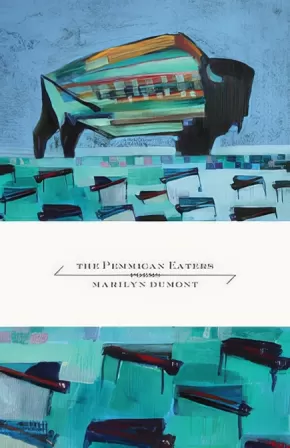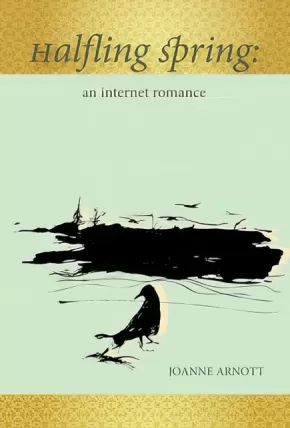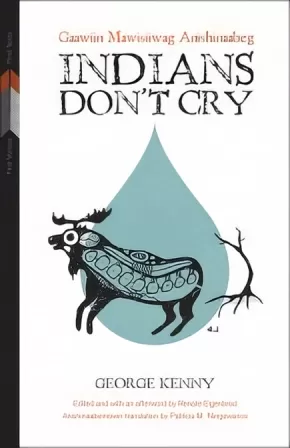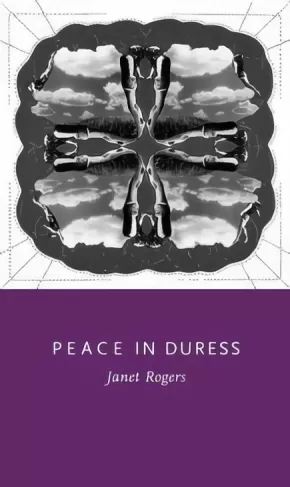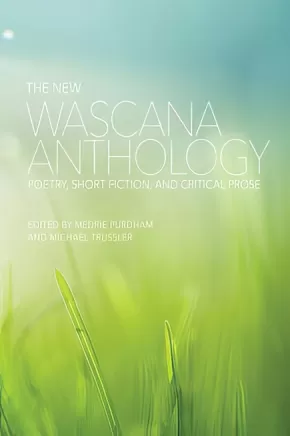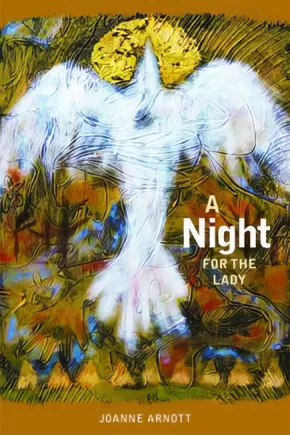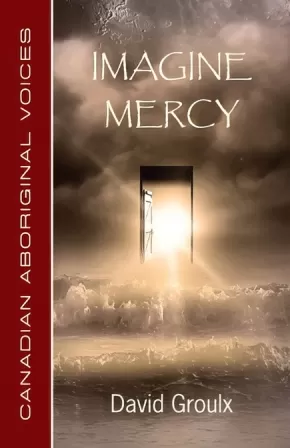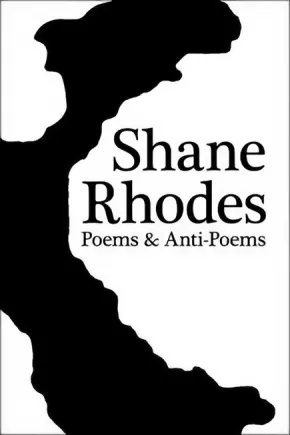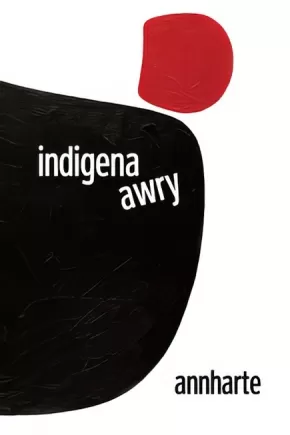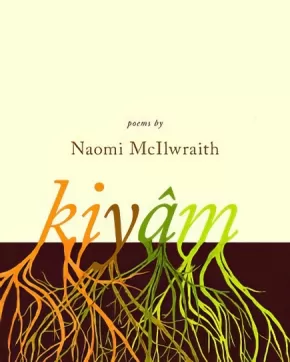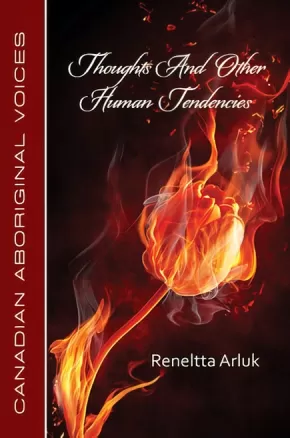Poetry
Synopsis:
A picture of the Riel Resistance from one of Canada’s preeminent Métis poets.
With a title derived from John A. Macdonald’s moniker for the Métis, The Pemmican Eaters explores Marilyn Dumont’s sense of history as the dynamic present. Combining free verse and metered poems, her latest collection aims to recreate a palpable sense of the Riel Resistance period and evoke the geographical, linguistic/cultural, and political situation of Batoche during this time through the eyes of those who experienced the battles, as well as through the eyes of Gabriel and Madeleine Dumont and Louis Riel.
Included in this collection are poems about the bison, seed beadwork, and the Red River Cart, and some poems employ elements of the Michif language, which, along with French and Cree, was spoken by Dumont’s ancestors. In Dumont’s The Pemmican Eaters, a multiplicity of identities is a strengthening rather than a weakening or diluting force in culture.
Awards
- Winner of the 2016 Stephan G. Stephansson Award for Poetry
Reviews
“A rollicking poem about the fiddle ('the first high call of the fiddle bids us dance/baits with its first pluck and saw of the bow/reels us, feet flick — fins to its lure and line') becomes a statement of cultural pride and defiance — much like The Pemmican Eaters as a whole.” — Toronto Star
“Dumont’s work is visual and evocative, highlighting recurring symbols and images of a natural world that will be familiar to any dweller of the Prairies . . . The Pemmican Eaters builds off the poet’s earlier work and highlights a writer who has mastered both craft and voice.” — Quill & Quire
“Dumont honours Métis traditions in music and beadwork in a number of lyrically driven poems. The Pemmican Eaters is a statement of cultural pride and defiance, much like Marilyn herself.” — CBC News Online
“Marilyn Dumont uses both rhythmic and free verse to provide a brilliant and insightful look at Métis and Cree people.” — Scene Magazine
Educator Information
This book would be useful for grades 9 - 12 in courses such as creative writing, English language arts, and social studies. Also recommended for students a college/university level.
Additional Information
96 pages | 5.50" x 8.50"
Synopsis:
The poetry of Clay Pots and Bones is Lindsay Marshall’s way of telling stories, of speaking with others about what things that matter to him. His heritage. His people. His life as a Mi’kmaw. For the reader, Clay Pots and Bones is a colourful journey from early days, when the People of the Dawn understood, interacted with and roamed the land freely, to the turbulent present and the uncertain future where Marshall envisions a rebirth of the Mi’kmaq. The poetry challenges and enlightens. It will, most certainly, entertain.
Additional Information
96 pages | 5.00" x 8.00"
Synopsis:
In the North Arm of British Columbia’s Fraser River lies an uninhabited island. In the midst of major industry and shipping, it is central to the waterfront of British Columbia’s original capital of New Westminster passed by daily by thousands of SkyTrain commuters. Poplar Island is lush and unspoken, but storied. It is the traditional territory of the Qayqayt First Nation. Made into property, a parcel of land belonging to the “New Westminster and Brownsville Indians,” this is the location of one of British Columbia’s first “Indian Reserves.”
This is also a place where Indigenous smallpox victims from the south coast were forced into quarantine, substandard care and buried. As people were decimated the land was taken and exchanged between levels of government. The trees were clear-cut for industry, beginning with shipbuilding during the First World War. The island still serves as booming anchorage for local sawmills.
From the Poplars is the poetic outcome of archival research, and of listening to the land and the stories of a place. It is a meditation on an unmarked, twenty-seven and a half acres of land held as government property: a monument to colonial plunder on the waterfront of a city, like many cities, built upon erasures. From an emplaced poet and resident of New Westminster, this text contributes to present narratives on decolonization. It is an honouring of river and riparian density, and a witness to resilience, tempering a silence that inevitably will be heard.
Synopsis:
In Halfling Spring , a series of notes unfolds the dance of desire versus trust through a long season of actual and metaphorical springtime.
Joanne Arnott is a Métis/mixed blood mother of six, and in this collection she continues her explorations of love, intimacy, and family, with a focus on electronic connections (internet love). Transiting Canada from Victoria to Iqaluit, and transitioning from virtual to real (fantasy to reality), she inspects the realms of miscegenation and love in a class conscious and cross-cultural context, revealing en route the many ways that our deepest connections unveil the depths of old pain.
Optimistic and playful, romantic and mythic, affirming embodiment, this process of poetic revelation shows all the dirty tricks of love.
Synopsis:
George Kenny is an Anishinaabe poet and playwright who learned traditional ways from his parents before being sent to residential school in 1958. When Kenny published his first book, 1977’s Indians Don’t Cry, he joined the ranks of Indigenous writers such as Maria Campbell, Basil Johnston, and Rita Joe whose work melded art and political action. Hailed as a landmark in the history of Indigenous literature in Canada, this new edition is expected to inspire a new generation of Anishinaabe writers with poems and stories that depict the challenges of Indigenous people confronting and finding ways to live within urban settler society.
Educator & Series Information
Indians Don’t Cry: Gaawin Mawisiiwag Anishinaabeg is the second book in the First Voices, First Texts series, which publishes lost or underappreciated texts by Indigenous artists. This new bilingual edition includes a translation of Kenny’s poems and stories into Anishinaabemowin by Patricia M. Ningewance and an afterword by literary scholar Renate Eigenbrod.
Although most of the books in this series are non-fiction, this one is listed as fiction.
Additional Information
190 pages | 5.50" x 8.50"
Synopsis:
Mohawk spoken-word artist Janet Marie Rogers's newest collection pulses with the rhythms of the drum and the beat of the heart. Poems drawing on the language of the earth and inflected with the outspoken vocality of activism address the crises of modern "land wars"-environmental destruction, territorial disputes, and resource depletion.
Synopsis:
The New Wascana Anthology is named for the Cree word "oskana," meaning "bones,"* but this anthology is no literary graveyard. It will introduce you to stories, poems, and essays that can be discussed over drinks, or used to impress friends years after leaving English 100 behind.
Offering a taster's choice of the best Canadian writing, with a special focus on Aboriginal and Prairie writers, this anthology includes pieces selected to introduce you to the English literary canon. Going back hundreds of years, the oldest poems included here have no known author, while the youngest writer is a recent university graduate.
Building on the bones of the canon (including all of Canada's Man Booker Prize-winners and newest Nobel Laureate), The New Wascana Anthology features writers such as Flannery O'Connor, Thomas King, Carmine Starnino, and Ursula K. Le Guin who will challenge your worldview. Most importantly, this anthology is about turning the page, opening your mind, and revelling in the pleasures of reading.
*The bones referred to are the bones of plains bison, a species that once numbered in the tens of millions on the Great Plains.
Educator Information
Contains works from Indigenous and non-Indigenous writers.
Table of Contents
Preface
Poetry
Anonymous
Summer is icumen in
Sir Patrick Spens
Mary Hamilton
Geoffrey Chaucer (ca. 1343–1400)
from The Canterbury Tales
Excerpts from General Prologue
Sir Thomas Wyatt (1503–1542)
The Long Love, That in My Thought Doth Harbour
Sir Walter Ralegh (ca. 1552–1618)
The Nymph’s Reply to the Shepherd
Edmund Spenser (ca. 1552–1599)
from Amoretti
30. My love is like to ice
75. One day I wrote her name
Sir Philip Sidney (1554–1586)
from Astrophel and Stella
59. Dear, why make you more of a dog than me?
Michael Drayton (1563–1631)
from Idea
61. Since there’s no help, come let us kiss and part
Christopher Marlowe (1564–1593)
The Passionate Shepherd to His Love
William Shakespeare (1564–1616)
from Sonnets
18. Shall I compare thee to a summer’s day?
20. A woman’s face, with nature’s own hand painted
116. Let me not to the marriage of true minds
130. My mistress’ eyes are nothing like the sun
from As You Like It
All the world’s a stage
John Donne (1572–1631)
A Valediction: Forbidding Mourning
Death be not proud
The Bait
The Flea
Ben Jonson (1572–1637)
Epigram XXII: On My First Daughter
Epigram XLV: On My First Son
Song: To Celia
George Herbert (1593–1633)
Love (III)
John Milton (1608–1674)
When I Consider How My Light Is Spent
from Paradise Lost, Book 1
The Invocation
Anne Bradstreet (1612–1672)
Before the Birth of One of Her Children
The Author to Her Book
Andrew Marvell (1621–1678)
To His Coy Mistress
Anne Finch, Countess of Winchelsea (1661–1720)
To the Nightingale
A Letter to Daphnis, April 2, 1685
Alexander Pope (1688–1744)
The Rape of the Lock
Lady Mary Wortley Montagu (1689–1762)
Addressed to—
Thomas Gray (1716–1771)
Elegy Written in a Country Churchyard
Christopher Smart (1722–1771)
from Jubilate Agno
My Cat Jeoffry
William Blake (1757–1827)
from Songs of Innocence
The Chimney Sweeper
The Lamb
from Songs of Experience
A Poison Tree
London
The Chimney Sweeper
William Wordsworth (1770–1850)
A slumber did my spirit seal
Composed Upon Westminster Bridge, September 3, 1802
I wandered lonely as a cloud
The world is too much with us
Samuel Taylor Coleridge (1772–1834)
Kubla Khan
George Gordon, Lord Byron (1788–1824)
She Walks in Beauty
The Destruction of Sennacherib
Percy Bysshe Shelley (1792–1822)
Ozymandias
John Keats (1795–1821)
La Belle Dame Sans Merci
When I have fears that I may cease to be
Alfred, Lord Tennyson (1809–1892)
Ulysses
Robert Browning (1812–1889)
Porphyria’s Lover
My Last Duchess
Emily Brontë (1818–1848)
Remembrance
Walt Whitman (1819–1892)
When Lilacs Last in the Dooryard Bloom’d
Matthew Arnold (1822–1888)
Dover Beach
George Meredith (1828–1909)
from Modern Love
17. At dinner, she is hostess, I am host
Emily Dickinson (1830–1866)
F479. Because I could not stop for Death
F591. I heard a Fly buzz—when I died
F620. Much Madness is divinest Sense
F1096. A narrow Fellow in the Grass
F1263. Tell all the Truth but tell it slant
Lewis Carroll (1832–1898)
Jabberwocky
Thomas Hardy (1840–1928)
The Ruined Maid
The Convergence of the Twain
The Workbox
Gerard Manley Hopkins (1844–1889)
God’s Grandeur
Pied Beauty
The Windhover
A. E. Housman (1859–1936)
from A Shropshire Lad
XIX. To An Athlete Dying Young
Sir Charles G. D. Roberts (1860–1943)
Tantramar Revisited
Archibald Lampman (1861–1899)
Heat
William Butler Yeats (1865–1939)
The Second Coming
Leda and the Swan
Crazy Jane Talks with the Bishop
Edwin Arlington Robinson (1869–1935)
Miniver Cheevy
Robert Frost (1874–1963)
After Apple-Picking
Mending Wall
Nothing Gold Can Stay
The Silken Tent
William Carlos Williams (1883–1963)
The Red Wheelbarrow
This is Just to Say
Pictures from Brueghel
D. H. Lawrence (1885–1930)
Piano
Snake
Ezra Pound (1885–1972)
In a Station of the Metro
The River Merchant’s Wife: A Letter
Isaac Rosenberg (1890–1918)
Break of Day in the Trenches
Edna St. Vincent Millay (1892–1950)
Elegy before Death
What lips my lips have kissed
Wilfred Owen (1893–1918)
Dulce et Decorum Est
e.e. cummings (1894–1963)
“next to of course god america i
anyone lived in a pretty how town
F. R. Scott (1899–1985)
Lakeshore
Langston Hughes (1902–1967)
The Negro Speaks of Rivers
Harlem
A. J. M. Smith (1902–1980)
The Lonely Land
Far West
Stevie Smith (1902–1971)
Not Waving but Drowning
Earle Birney (1904–1995)
Anglo-Saxon Street
W. H. Auden (1907–1973)
Musée des Beaux-Arts
Theodore Roethke (1908–1963)
My Papa’s Waltz
A. M. Klein (1909–1972)
Heirloom
The Rocking Chair
Dorothy Livesay (1909–1996)
Green Rain
Elizabeth Bishop (1911–1979)
In the Waiting Room
Irving Layton (1912–2006)
The Birth of Tragedy
Dylan Thomas (1914–1953)
Fern Hill
Do Not Go Gentle into That Good Night
P. K. Page (1916–2010)
After Rain
Planet Earth
Robert Lowell (1917–1977)
For the Union Dead
Miriam Waddington (1917–2004)
Advice to the Young
Raymond Souster (1921–2012)
The Lilac Poem
Elizabeth Brewster (1922–2012)
The Night Grandma Died
Eli Mandel (1922–1992)
Houdini
Anne Szumigalski (1926–1999)
It Wasn’t a Major Operation
Don Coles (b. 1927)
Collecting Pictures
Robert Kroetsch (1927–2011)
Meditation on Tom Thomson
Rita Joe (1932–2007)
Axe Handles for Sale
I Lost My Talk
Sylvia Plath (1932–1963)
Daddy
Alden Nowlan (1933–1983)
The Bull Moose
Leonard Cohen (b. 1934)
A Kite Is a Victim
Suzanne
Robert Currie (b. 1937)
Young Boy, Fleeing
Glen Sorestad (b. 1937)
Ten Years
Now That I’m Up
John Newlove (1938–2003)
The Double-Headed Snake
Margaret Atwood (b. 1939)
Backdrop Addresses Cowboy
The Nature of Gothic
This Is a Photograph of Me
Seamus Heaney (1939–2013)
Bog Queen
Digging
The Names of the Hare
Patrick Lane (b. 1939)
Mountain Oysters
Gary Hyland (1940–2011)
from Arguments in the Garden of Prayer
1. So many frogs
14. The first sounds
Beth Brant (b. 1941)
for all my Grandmothers
Robert Hass (b. 1941)
Consciousness
Gwendolyn MacEwen (1941–1987)
Manzini: Escape Artist
Marie Annharte Baker (b. 1942)
Pretty Tough Skin Woman
Louise Glück (b. 1943)
Illuminations
Michael Ondaatje (b. 1943)
The Cinnamon Peeler
White Dwarfs
Dennis Cooley (b. 1944)
how there in the plaid light she played with his affections plied them spikes from his heart she stood by pliers in hand he has his pride
Craig Raine (b. 1944)
A Martian Sends a Postcard Home
Tom Wayman (b. 1945)
Did I Miss Anything?
Linda Hogan (b. 1947)
Cities Behind Glass
Lorna Crozier (b. 1948)
The Dirty Thirties
Poem about Nothing
from The Sex Lives of Vegetables
Radishes
Lettuce
Cauliflower
Beth Cuthand (b. 1949)
Four Songs for the Fifth Generation
Kathleen Wall (b. 1950)
Morning Nocturne
Joy Harjo (b. 1951)
She Had Some Horses
Gerald Hill (b. 1951)
Becoming and Going: An Oldsmobile Story
Di Brandt (b. 1952)
completely seduced
Louise Halfe (b. 1953)
She Told Me
Louise Erdrich (b. 1954)
Dear John Wayne
Indian Boarding School: The Runaways
Jacklight
Jeanette Lynes (b. 1956)
The Last Interview with Bettie Page
Anne Simpson (b. 1956)
Grammar Exercise
George Elliott Clarke (b. 1960)
Blank Sonnet
Michael Crummey (b. 1965)
Her Mark
Gregory Scofield (b. 1966)
His Flute, My Ears
Karen Solie (b. 1966)
Parasitology
Randy Lundy (b. 1967)
Bear
Ghost Dance
Stephanie Bolster (b. 1969)
To Dolly
Carmine Starnino (b. 1970)
Pepino’s Poem, “Growing Up in Naples”
Rope Husbandry
Daniel Scott Tysdal (b. 1978)
Metro
Cassidy McFadzean (b. 1989)
I smile earwide
Short Fiction
Sherman Alexie (b. 1966)
The Approximate Size of My Favourite Tumour
Margaret Atwood (b. 1939)
My Last Duchess
Sandra Birdsell (b. 1942)
Disappearances
Raymond Carver (1938–1988)
Cathedral
William Faulkner (1897–1962)
A Rose for Emily
Richard Ford (b. 1944)
Sweethearts
Charlotte Perkins Gilman (1860–1935)
The Yellow Wall-paper
James Joyce (1882–1941)
Araby
Thomas King (b. 1943)
A Seat in the Garden
Ursula K. Le Guin (b. 1929)
The Ones Who Walk Away from Omelas
Alexander MacLeod (b. 1972)
Miracle Mile
Alistair MacLeod (1936-2014)
The Boat
Katherine Mansfield (1888–1923)
The Garden-Party
Yann Martel (b. 1963)
The Facts Behind the Helsinki Roccamatios
Rohinton Mistry (b. 1952)
Swimming Lessons
Ken Mitchell (b. 1940)
The Great Electrical Revolution
Alice Munro (b. 1931)
The Bear Came over the Mountain
Flannery O’Connor (1925–1964)
A Good Man Is Hard to Find
Edgar Allan Poe (1809–1849)
The Cask of Amontillado
Eden Robinson (b. 1968)
Traplines
Gloria Sawai (1932–2011)
The Day I Sat with Jesus on the Sundeck and a Wind Came Up and Blew My Kimono Open and He Saw My Breasts
Guy Vanderhaeghe (b. 1951)
Dancing Bear
Dianne Warren (b. 1950)
Bone Garden
Critical Prose
Stephen Jay Gould (1941–2002)
Evolution as Fact and Theory
Trevor Herriot (b. 1958)
from Grass, Sky, Song: Promise and Peril in the World of Grassland Birds
A Way Home
Barbara Kingsolver (b. 1955)
Setting Free the Crabs
Don McKay (b. 1942)
Baler Twine: Thoughts on Ravens, Home, and Nature Poetry
Jonathan Swift (1667–1745)
A Modest Proposal
Copyright Notices
Index of Authors and Titles
Index of First Lines of Poetry
Additional Information
554 pages | 6.00" x 9.00" | Paperback
Synopsis:
A Night for the Lady explores the terrain of poetry conversation. Each poem arises from conversations with poets, colleagues and intimate friends. They range from a 1998 conversation on healing programs and the fundamentals of world change to a sequence of recent indigenous literary events on the prairies. Within the context of these conversations, an exploration emerges of the roles of woman within local as well as historic literary and global situations. The poems draw together diverse figures from world literature, world religions and myths to lay open the experience of human beings within the “brown-feminine.” Identifying and synthesizing connections across a wide palette of human experience, this collection challenges the divisions of personal and global, indigenous and “everyone else,” all the while celebrating both the humanity and the divinity of the Lady. Playful, erotic and occasionally harrowing, this collection bundles together experimental and inspirational work from a longstanding voice of conscience in Canadian letters. Once again, Arnott carries us into the most intimate terrain, casts her net widely, catches us up.
Synopsis:
Imagine Mercy is a vibrant poetry collection portraying the daily realities of living as an Aboriginal in Canada. David Groulx seamlessly weaves the spiritual with the ordinary and the present with the past. He speaks for the spirit, determination, and courage of Aboriginal people, compelling readers to confront cruel reality with his honest and inspiring vision. The poems in Imagine Mercy portray mixed bloods, resistance, determination, sovereignty, and cultural issues that generate sharply divided opinions and deep emotional struggles. Groulx’s poetic power renders an honest and painful perception of modern-day Aboriginal life with strong voice against prejudice and injustice.
Educator & Series Information
This book is part of the Canadian Aboriginal Voices series.
Additional Information
96 pages | 5.50" x 8.50"
Synopsis:
The Place of Scraps revolves around Marius Barbeau, an early-twentieth-century ethnographer, who studied many of the First Nations cultures in the Pacific Northwest, including Jordan Abel’s ancestral Nisga’a Nation. Unfortunately, Barbeau’s methods of preserving First Nations cultures included purchasing totem poles and potlatch items from struggling communities in order to sell them to museums. While Barbeau strove to protect First Nations cultures from vanishing, he ended up playing an active role in dismantling the very same cultures he tried to save.
Through the use of erasure techniques, Abel carves out new understandings of Barbeau’s writing – each layer reveals a fresh perspective, each word takes on a different connotation, each letter plays a different role, and each punctuation mark rises to the surface in an unexpected way. As Abel writes his way ever deeper into Barbeau’s words, he begins to understand that he is much more connected to Barbeau than he originally suspected.
Synopsis:
One of the first lines of X, Shane Rhodes' sixth book of poetry, is a warning: "this book of verse demands more of verse, this book demands perversity."
In X, Rhodes takes poetry from the comfortable land of the expected to places it has seldom been. Writing through the detritus of Canada's colonization and settlement, Rhodes' writes poems to and with Canada's original documents of finding and keeping. He writes a poem to each of the eleven numbered treaties (the Post Confederation Treaties between many of Canada's First Nations and the Queen of England)--he writes to the fonts he finds in Treaty 5, the river he finds in Treaty 6, and the chemicals he finds in Treaty 8. Rhodes' writes poems to and with the Indian Act.
Beyond the treaties, Rhodes writes formal poetry using Indian status registration forms. He writes to the memory of Oka. He writes to the Government of Canada's Apology for the Indian Residential School System. He writes to the procreating beavers he finds in the Royal Charter of the Hudson Bay Company. X culminates in "White Noise," a long poem grown from Canada's collective rants, threats, cries and shouts in response to the Idle No More protests and the hunger strike of Chief Theresa Spence.
Through out the book, Rhodes surprises with what poetry and art can actually do with the seemingly unsalvageable and un-poetic that surrounds us. The design of X is also exhilarating. Not only is the book reversible--it must be read in two directions--but every page bursts with design, interference and thought.
X sings a new national anthem for Canada, an anthem stripped of patriotic fervor that truly sings of the past many would rather forget and the current state of Indigenous/settler race relations in Canada, an anthem fit for "a land held by therefores, herebys and hereinafters."
Synopsis:
NDN word warrior Marie Annharte Baker's fourth book of poems, Indigena Awry, is her largest and wildest yet. It collects a decade's worth of verse — fifty–nine poems.
Set noticeably in Winnipeg and Vancouver, but in many other places on either side of the Medicine Line as well, the poems are a laser–eyed meander through contested streets filled with racism, classism, and sexism. Shot through with sex and violence and struggle and sadness and trauma, her work is always set to detect and confront the delusions of colonialism and its discontents.
These poems are informed by a sceptical spirituality. They call for justice for NDNs through the Permanent Resistance that goes around in cities. This is bruising and exacting stuff, but Annharte is also one of poetry's best jokers.
In Indigena Awry, you can find fictitious girl gangs coexisting with real boy ones. NDN grannies may be found flirting salaciously in some internet chat room. One might use duct tape to prevent a war. You might be worried that hand–signalling for a Timbit on an airplane flight will be considered a terrorist act.
Annharte may be seam–walking a singular path but she is not without allies. In the United States, they could include Leslie Marmon Silko and Chrystos. In Canada, Beth Brant and Gerry Gilbert. The jazz inflections of Beat writing are often apparent in her work. She swings from a poetic madness into a mad poetics. Way under it all, acting as a deep sort of platform, could be considered the Kenyan writer Ngugi wa Thiong'o's project of decolonizing one's mind. Both sketch out an argument that we will not see, feel, or respond correctly in or to our own lives without doing this, because otherwise we will be living within a philosophical myopia generated by a bad fiction.
While Indigena Awry is written for NDN persons, it is highly recommended for truth–seekers of every nature and anarchs of word and spirit. In an Annharte poem you might lose your way only to find what's important.
Synopsis:
Through poems that move between the two languages, McIlwraith explores the beauty of the intersection between nêhiyawêwin, the PlainsCree language, and English, âkayâsîmowin. Written to honour her father's facility in nêhiyawêwin and her mother's beauty and generosity as an inheritor of Cree, Ojibwe, Scottish, and English, kiyâm articulates a powerful yearning for family,history, peace, and love.
Synopsis:
This book is one woman's examination of her role as an otepayemsuak, a Métis, in this 500-year era of resistance and change. We are in a time when many Indigenous prophecies are reaching into the present - those of the ancient Mayan, the Hopi, the Iroquois, the Cree, the Métis. As with the ancient Mayan, where December 12, 2012, marks the end of the long count calendar, according to the prophecy of the Mohawk's seventh generation, we have reached the time to restore Indigenous stewardship of the land. The words that follow the title of the first chapter of the trees are still bending south, are those of Louis Riel: "My people will sleep for one hundred years. When they awake, it will be the artists that give them back their spirit."
Synopsis:
A poetry collection where stories of life’s experiences are distilled into feelings and thoughts that are universal. Reneltta Arluk weaves the traditional and the contemporary together through the eyes of a young Aboriginal woman. Her poems, both sacred and secular, are written with the passions of anger, grief, and love, at once tender and furious. Here are tales of love, betrayal, courage, defeat, acceptance, loss, grief, passion, delight, courting, coming of age, birth and death, youth and old age, hunting and surviving. The poems are united by the history of her ancestors and the ongoing struggle to define what it means to be a tribal member, an Aboriginal, and a woman in the twenty first century.
Educator & Series Information
This book is part of the Canadian Aboriginal Voices series.
Additional Information
|

